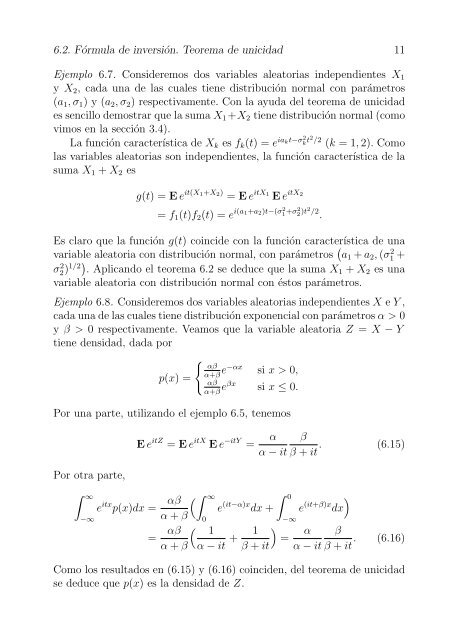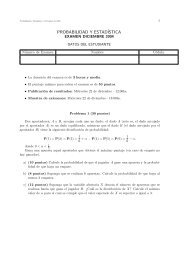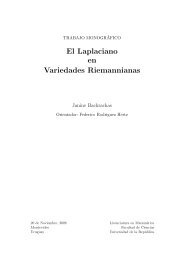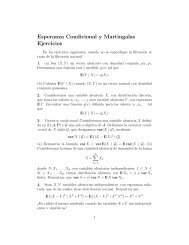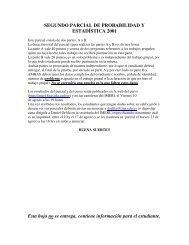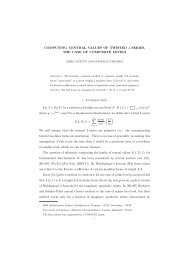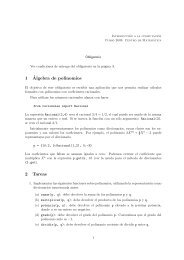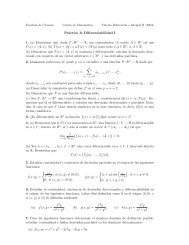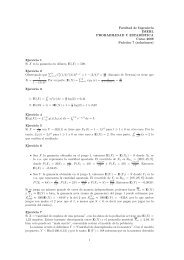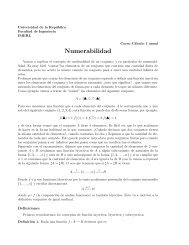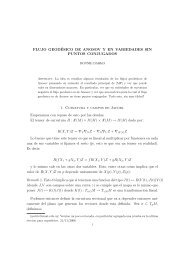CapÃtulos 6 y 7 de Petrov. V.V, Mordecki, E. TeorÃa de la ...
CapÃtulos 6 y 7 de Petrov. V.V, Mordecki, E. TeorÃa de la ...
CapÃtulos 6 y 7 de Petrov. V.V, Mordecki, E. TeorÃa de la ...
Create successful ePaper yourself
Turn your PDF publications into a flip-book with our unique Google optimized e-Paper software.
6.2. Fórmu<strong>la</strong> <strong>de</strong> inversión. Teorema <strong>de</strong> unicidad 11Ejemplo 6.7. Consi<strong>de</strong>remos dos variables aleatorias in<strong>de</strong>pendientes X 1y X 2 , cada una <strong>de</strong> <strong>la</strong>s cuales tiene distribución normal con parámetros(a 1 , σ 1 ) y (a 2 , σ 2 ) respectivamente. Con <strong>la</strong> ayuda <strong>de</strong>l teorema <strong>de</strong> unicida<strong>de</strong>s sencillo <strong>de</strong>mostrar que <strong>la</strong> suma X 1 +X 2 tiene distribución normal (comovimos en <strong>la</strong> sección 3.4).La función característica <strong>de</strong> X k es f k (t) = e ia kt−σ 2 k t2 /2 (k = 1, 2). Como<strong>la</strong>s variables aleatorias son in<strong>de</strong>pendientes, <strong>la</strong> función característica <strong>de</strong> <strong>la</strong>suma X 1 + X 2 esg(t) = E e it(X 1+X 2 ) = E e itX 1E e itX 2= f 1 (t)f 2 (t) = e i(a 1+a 2 )t−(σ 2 1 +σ2 2 )t2 /2 .Es c<strong>la</strong>ro que <strong>la</strong> función g(t) coinci<strong>de</strong> con <strong>la</strong> función característica <strong>de</strong> unavariable aleatoria con distribución normal, con parámetros ( a 1 + a 2 , (σ 2 1 +σ 2 2) 1/2) . Aplicando el teorema 6.2 se <strong>de</strong>duce que <strong>la</strong> suma X 1 + X 2 es unavariable aleatoria con distribución normal con éstos parámetros.Ejemplo 6.8. Consi<strong>de</strong>remos dos variables aleatorias in<strong>de</strong>pendientes X e Y ,cada una <strong>de</strong> <strong>la</strong>s cuales tiene distribución exponencial con parámetros α > 0y β > 0 respectivamente. Veamos que <strong>la</strong> variable aleatoria Z = X − Ytiene <strong>de</strong>nsidad, dada por{αβα+βp(x) =e−αx si x > 0,αβα+β eβx si x ≤ 0.Por una parte, utilizando el ejemplo 6.5, tenemosE e itZ = E e itX E e −itY =α βα − it β + it . (6.15)Por otra parte,∫ ∞−∞e itx p(x)dx =αβ ( ∫ ∞)e (it−α)x dx + e (it+β)x dxα + β 0−∞= αβ ( 1α + β α − it + 1 )= α ββ + it α − it β + it . (6.16)Como los resultados en (6.15) y (6.16) coinci<strong>de</strong>n, <strong>de</strong>l teorema <strong>de</strong> unicidadse <strong>de</strong>duce que p(x) es <strong>la</strong> <strong>de</strong>nsidad <strong>de</strong> Z.∫ 0


